Somnambulism: Phantasmagoric Fugue
Written By / Guo, Jau-lan
Associate Professor, Graduate Program in Fine Arts, National Taiwan University of Arts
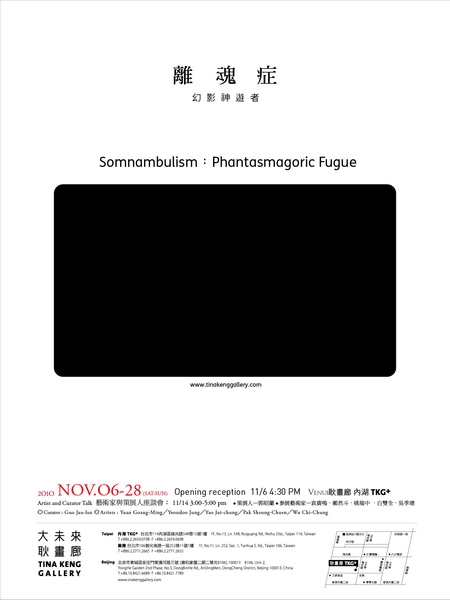
The concept of somnambulism—can be traced back to ancient Chinese medicine, where it broadly refers to an incompleteness of a person’s soul. The soul, comprised of three finer compounds hun and seven baser instincts po, becomes incomplete, when two huns and six pos are disoriented from the body, or in the condition where a non-native soul inhabits the body of a corporeal host. Somnambulism originally explained the inquilinous relationship between the body and the soul. However, in this world of excessive imagery, faraway imaginings can now travel anywhere. With the huge volume of visions and images circulated throughout society, imagination is no longer restricted to being simply a postscript to reality; they are now completely intertwined with the pulse of the other. Somnambulating has become a communal energy. Rather than endangering the corporeal centrality of the soul, it instead crosses the borders between various worlds: the personal and the communal, reality and virtuality, the illusory and the corporeal, time and space
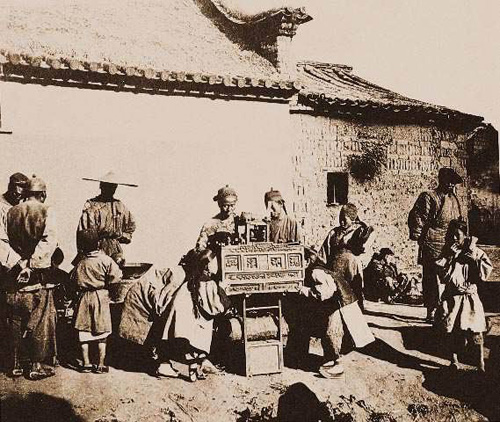
Figure 1, Auguste François, Kunming, China, 1900
.
Figure 1 shows children in Kunming, China enjoying a Western kinetoscope (photographed by Auguste François of France, 1900), although this form of viewing illusions may have occurred even earlier in Taiwan’s history. According to film historian Ye Long-yan’s The History of Taiwanese Movies During the Japanese Colonization, “The Japanese sold the new toys called kinetoscopes on Jianchang Street in August, 1896... This kind of business involved temporarily renting a space for the kinetoscopes, as they were extremely heavy and bulky, and had to be shipped by boat to the shore of the Danshui River... Taipei’s kinetoscopes were the earliest recorded cinematic experience in Asia.”
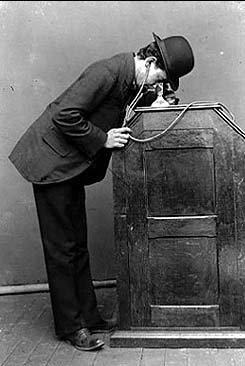
Figure 2, Kinetoscope with Phonograph built-in cylinder audio player and earphones, 1895
Although the phrase “uncovering your kinetoscope” explains how “the viewing of visual illusions” entered the Chinese-speaking world, the binary of reality and phantasmagoria was still accepted as a deception of reality. However, following the spread of movies and mass media, the simple real/illusory duality was torn away with the increasingly complex system of capital, media, consumerism, viewers and politics. Illusion morphed into a wide variety of imaginary images, with both a spiritual and physical existence, entwined with all manners of everyday utopia-reliant images. The conjuration of images has now permeated every aspect of our daily lives, weaving illusions and cognition together in contemporary city life.
The intersection of images and illusions is not only seen in the physical nature of tools, but also in the blending and influencing of society. The 17th century Jesuit scholar Athanasius Kircher used the Magic Lantern technique to project images of demons, manipulating rays of light to call forth these spirits.
Etienne Gaspard Robertson was a Belgium projectionist that lived in Paris during the 19th century. He also emphasized that his “phantasmagoria” was in fact the summoning of spirits. Robertson would set up theater-style projections in the ruins of old monasteries, and then make viewers walk through a dark corridor towards a space filled with human skulls. He would mix chemicals to create smoke, and then use a hidden projector to project images onto the smoke while “calling forth the spirits” with a glass harmonica.
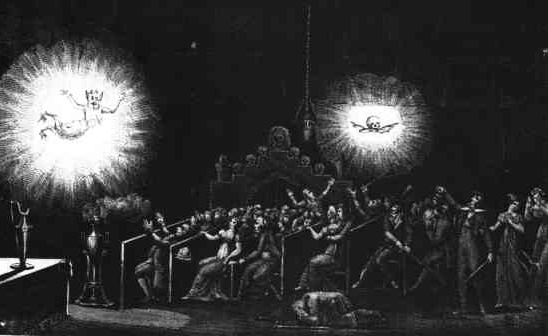
Figure 3, Belgian projectionist Etienne Gaspard Robertson performing his Phantasmagoria in the ruins of an old monastery in Paris, 1797
Having grown quite popular in the 19th century, phantasmagoria subtly became a meeting point between life and death, reality and illusion, the corporeal and the spiritual, and the scientific/physical and the emotional. In the meantime, while phantasmagoria fills the need for visual public entertainment, if it also constructs an instrumental culture that deals with the projection of non-existent objects and summoning of collective imaginations: Then how does the dreamland of contemporary media create a connection between our non-existent imaginings?
“All that is solid melts into air.” – Karl Marx. At the end of 2000, Zygmunt Bauman offered “liquid modernity,” echoing Marx’s outcry. Bauman had thought that we had already distanced ourselves from the past notion that “occupying space” is paramount. While the industrial revolution and the era of capitalism focused on solid, concrete modernity, we are now entering the second stage of modernity – liquid modernity. In this liquid modernity, with its prevalence of mass media, internet and instantaneous inter-personal communication, “the restrictions of space and domain no longer form key factors in modern society, as they are replaced by the emphasis liquid modernity places on time, speed and change.”
In the age of the internet, daily life has become more and more like staring through different windows: staring at movies, staring at TVs, staring at computer screens, staring at iPods, staring at cell phones. Windows have been a key element in buildings, and today Windows is the virtually “universal” name for computers. Windows now provides us fugues of entryways entangled with reality. “Mass media allows people to imagine more possible lifestyles than they ever could before, including many which have successfully become a part of our everyday lives,” Modernity at Large author Arjun Appadurai examines images, imaginings and globalization and sees the power in their communal imagination. Imagination in today’s world not only possesses concrete social power, but also offers new resources, and a new energy for creating new races/countries (although some people believe this era is on the verge of ending).
Five artists were invited to present at Somnambulism: Phantasmagoric Fugue, including Taiwanese artists Yao Jui-chung, Yuan Goang-Ming and Wu Chi-Tsung, Korean artist Yeondoo Jung, and Hong Kong artist Pak Sheung Chuen. In the context of their artistic practice, Yuan Goang-Ming and Wu Chi-Tsung find themselves in the reflexive stance of excavating the modernity of video art in a spectacle of image overflow. Yeondoo Jung, on the other hand, wields video art like an illusionistic magician, with the precision of rehearsed film crews and props, while manually employing “long-takes” to challenge the limits of illusion and imagination. Yao Jui-chung, applying the methods of post-archive, evokes an epiphany of collective memory, with a dark-humored veil. Lastly, the artist from Hong Kong, Pak Sheung Chuen traveling with masked eyes, suggests a return to innocence, a feasible path “without visual interference.”
Yeondoo Jung
Six Points
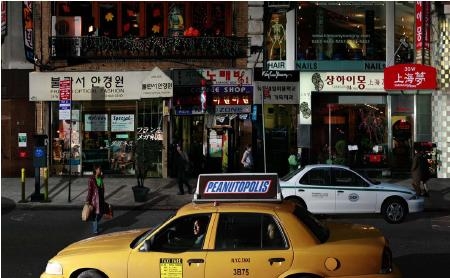
Among the metaphors of photography, memory is considered one of the most common. An old photograph will always link to a memory in the past, providing a reasonable entry point for imagination. It could also imply a convention of documentary, especially a family photograph or archived photos. However, Jung’s aesthetics have consistently been a form of “see the mountain that is a mountain, see the mountain that is not a mountain, and see the mountain that still is the mountain,” a kind of reverse illusion. This may be the most difficult kind of photography to understand, yet one that allows the viewer to experience the happiness of memory and image aesthetics.
Unlike in Handmade Memories, in which movies were used to recreate illusory memories, Jung uses an entirely new route to continue his phantasmagoric memory engineering in Six Points. In this piece, Jung uses cityscape photographs from six immigrant districts in New York to create an animated work. These six areas include the Indian population center of Jackson Heights, Little Italy, Chinatown, Koreatown, Roosevelt Avenue with its high number of Mexican immigrants, and the Russian community of Brighton Beach. The entire animation was created from nearly one thousand photos, stitched together to make a single quiet horizontal landscape/still life; the animation slowly plays against an immigrant's heavily-accented narration.
“I made an animation of a time-frozen city, and you are the only one who is awake and listening to one of these people's life story,” the artist explained in 2006 as he began making this piece in New York. He used a 3000-watt flash installed on a cart to take a single picture every meter along all six of the locations. The flash turned the views into animated movie scenes and the pedestrians into its actors. Jung uses the sounds and memories of immigrants to create completely new local visions that belong to them. Due to its unique geopolitics, the cityscape becomes a stage where immigrants can project their memories.
Reality is found somewhere between truth and imagination. Six Points reflects on a twisted reality, swinging in the gap between the fabricated and the real. Viewers are thrown into the unlimited interstices between the narration of these scattered immigrants and their corresponding streetscapes, the interstices between understandable American English and the various accents of the immigrants’ original countries.
Along with the horizontal movement of scrolls, Jung’s piece opens several wormholes, connecting different time-spaces, within the assembled frozen time fragments of phantasmagoria. In discussing the existence of these drifting immigrants, Six Points provides a contradictory imagination of disorientation and reorientation under the displacement of time and space. The relationship between the images and the colloquial narrative expands the distance between them, to a blurred, indeterminate zone existing between the individual and the communal.
Weaving together the images from these six city points, Jung creates an imaginary city that expands horizontally. It is a dense, high-resolution artificial view, an illusory city that has cast off the wheels of time. If this virtual streetscape—constructed of real streets, but also emitting electronic glow–does not reflect the imagination and reality of those cross-global immigrants, then this non-existent cityscape would be the phantasmagoric city within all globalized cities: A phantasmagoric city that exists everywhere. It invariably resides between reality and imagination, mediating the fluidity of identity, yearning and memory.
Hanging Garden

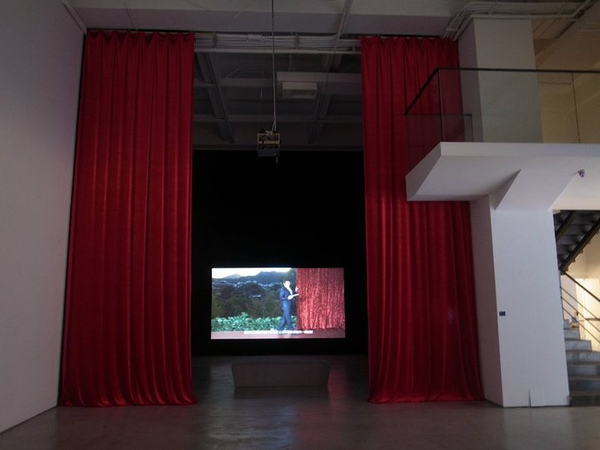
An old story helps explain the tradition of images and illusions. In “Natural History,” Pliny the Elder described a competition between two outstanding painters of ancient Greece, Zeuxis and Parrhasius, to see who could create the most convincing illusion. First, Zeuxis painted grapes, which were so vivid that small birds that came to peck at them. Able to even fool mother nature with his optical illusion (trompe l’oeil), Zeuxis was certain of his victory. He confidently walked towards Parrhasius’ work, saying, “Draw back the curtains on your piece, and let us see what you have painted!” Zeuxis was shocked to find that the curtains covering his opponent’s work were in fact the painting itself. Zeuxis was fooled by Parrhasius’ illusion, and was forced to admit defeat.
When Jacques Lacan recounted this fable in 1964, these two artists each clearly demonstrated two kinds of image: one, the ability to attract, and the other, the ability to deceive the eyes. Parrhasius’ image was a metaphor for paintings that are like a veil, so that people are enticed to ask what is behind them. If Parrhasius’ cloth curtains were an allegory for an image acting as visual bait, then Jung’s Hanging Garden transforms the illusion of the grapes into the “live-action realism” of “finding a view in the vineyard.” Jung makes this infinitely familiar media bait both broad and expansive, and asks “where will the persuasiveness of images take us?”
True to the film host’s words, Hanging Garden is a live-action film. Jung utilizes the narrative strategy commonly adopted by mainstream media: shot a real place, with the narration of history, stories of people and background images often seen in weather reports, and add an authoritative host that occasionally refers to the images. The scene behind the curtain is the Gyeongbok Palace in Seoul, built during the Korean Joseon Dynasty in the 14th century. The artist selected dusk for this scene, captured by setting up a camera on the roof of the nearby Korean Defense Security Command in a single-shot documentary style. Nothing is artificial in the scene behind the host except for the curtain and a few trees in the foreground. Yet the historical allusion narrated by this solemn host is completely fabricated and baseless; it simply once again uses the convention of an authoritative narration.
The host stands within a television-like frame, slowly moving the curtain, as he authoritatively explains the distant objects behind him. Along with his commanding narrative, he also slowly moves his body as the audience solemnly listens to his unfolding story. With the real background objects clearly shown, the ‘reality’ of the scene transforms into the ‘evidence’ of the host’s narration. The scene between the curtains can be likened to the images placed behind television news anchors. The real and the fabricated instantly decouple. Gyeongbok Palace, which could not be more a concrete entity, suddenly becomes ’suspended leading us to think that the ‘hanging’ in the title of this piece hints at much more than merely a “suspended” garden.
Viewers will also see some of the making process behind Hanging Garden on a smaller screen, including the team’s careful planning process and the moving of the props. Jung’s work reveals those things that are invisible, such as stage props and the actual performance itself, to create a gray area between imagination and imagery. The high-tech 3D digital processing and the cuts, are achieved instead with the most non-technological, ‘realistic,’ and mechanically precise methods possible, along with the physical exertion of rehearsal. On the one hand he utilizes photography and cameras, while on the other, he is suspicious of the transparency of photography and cameras. But the important point is that Hanging Garden was not planned to extinguish the allure of illusionary images; the act of contemplation simply does not end such a dialogue due to deceit.
Yao Jui-chung
Phantom of History Series
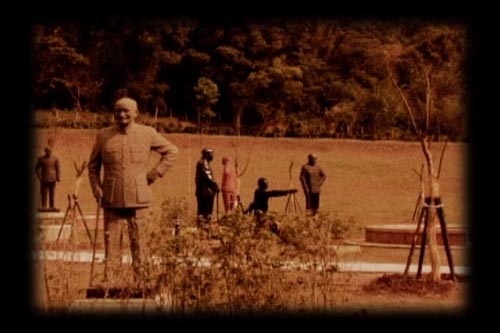
“Having lived through the turbulent 90’s, everything around you seemed empty, drifting balloons, light and airy. Yet the past does not disappear, it simply transforms into phantoms, hovering about in the air.” Growing up in the 1960’s, Yao Jui-chung took the collective memory of Taiwan’s martial law at the time and brought them back to life. This makes one think of Jacques Derrida’s words, “"It is never to rest, interminably, from searching for the archive right where it slips away.
It is to run after the archive, even if there's too much of it, right where something in it anarchives itself.".
In the Phantom of History series, the artist seems to have been possessed by the phantom of history itself, which shows itself in three different scenes: Jade Mountain, a march past the Office of the President, and the Chiang Kai Shek Memorial Sculpture Park in Cihu. The first two image prototypes are from the martial law era, when the national machine created a kind of leader-worshipping in the media. Remolding memory is often a necessary tool in the formation of the nation. But if the nation is phantomized, then the spirit will reside in the individual. Here history becomes a ready-made object from collective memory, waiting to be created, deployed, allocated or recreated. As Yao ridicules the illusions of the martial law state, he also projects a contemporary media-saturated collective political consciousness.
Chinatown – Dizzy
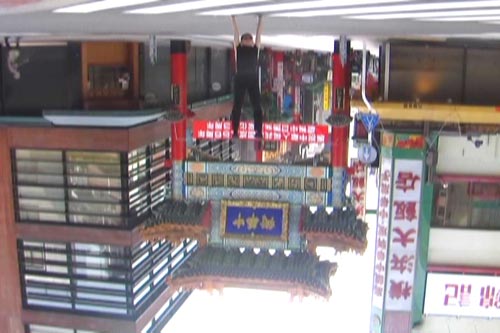
Chinatown – Dizzy traces its origins from Yao’s project entitled The World is For All – China Beyond China, begun in 1997. Yao traveled to Chinatown gates in major cities around the world, including Vancouver, Toronto, Philadelphia, Paris, New York, Victoria, San Francisco, Yokohama, London, Brisbane and Taipei, using his body as an “I was here” to ask the question “Just where is China?” While exploring the concept of self-identification, globalism and political identification. Yao’s Chinatown – Dizzy is performance / video art conducted at the Chinatown in Yokohama.
In front of a spinning video camera, Yao slowly walks into the picture and performs handstands, even as the frame continues to spin. As the artist reaches the center of the picture, precisely as the image turns upside-down, he completes his handstand. Whether he is attempting to use his body to prove “I was here,” or using the upside-down image / body to overturn each other, the scene created is similar to the predicament faced by immigrants moving into these areas. This turning upside down is dizzying – much like the turning over of dreams.
Yuan Goang-Ming
Disappearing Landscape – Passing
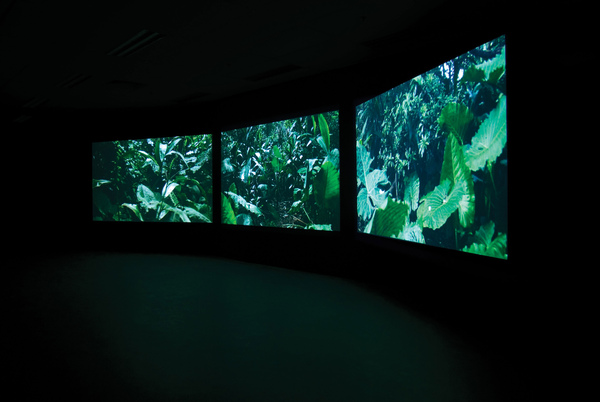
In the documentary The Man with a Movie Camera, Russian director Dziga Vertov describes the camera: “I am an eye, a mechanical eye. I, the machine will show you your world the way only I can see it. I free myself for today and forever from human immobility. I’m in constant movement. I approach and pull away from objects. I creep under them. I move alongside a running horse’s mouth. I fall and rise with the falling rising bodies. This is I, the machine.” The director uses the style of montage to create the personification of cameras, much like the film today, preserving the parable of the camera: long-legged cameras (Figure 4).
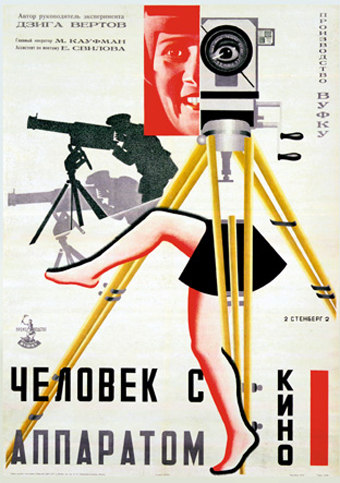
Figure 4, Dziga Vertov The Man with a Movie Camera jacket
Disappearing Landscape – Passing involves installing three cameras on straight steel wires at different heights, with motors attached to the cameras to allow them to slowly move along. After computer post-processing, the images are suddenly thrust into everyday scenes, rotating around as if to flee. Moving cameras make people think of the classic walking camera images. What is different, however is that Vertov believed that the camera eye he held would cast off the rigidness of humanity, and show people what they are incapable of. Yet Yuan’s steel wires seem to return these metaphor-loaded tools of modern utopia to a kind of original pre-modern form. Sliding cameras facing a non-existent vanishing point subtly cuts apart and pierces through time and space, passing us by with every disappearing moment of daily life.
The images that slip into Disappearing Landscape – Passing compress real time and the timing of moving cameras into one. The timing of the image frames are sliced into pieces, overlapped with the timing of the physical movement, giving people an image of time itself collapsing. As a result, this piece interprets time, which is difficult to describe, within the context of space. Yet due to the existence of visual narrative, the moving images naturally tell of a vanishing past. When those everyday sights of the artist enter the shot, the laws of universal time are not cast away. Using ça-a-été as truth, these are mixed into a single entity, giving it the title ‘we were here.’ They mix the ideas of existing and existed, yet what is gone is gone, and all we have left is the image of ‘we were here,’ much like a ghost. The melancholic nature of photography creates an apprehension within Disappearing Landscape – Passing.
Wu Chi-Tsung
Dust
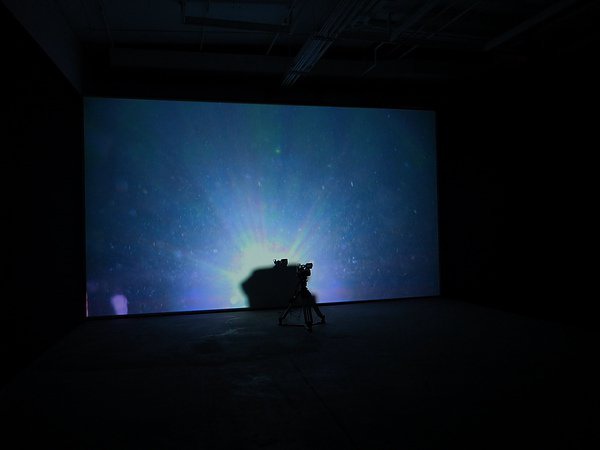
In Time Exposure and Snapshot: The Photograph as Paradox, Thierry de Duve explained, “More than any other image-producing practices, the photograph puts the beholder in contact with the world, through a paradoxical object which, because of its indexical nature, belongs to the realms of uncoded things, and to the sphere of codified signs.” He went on to say, “Photograph doesn’t allow an intermediate position, or a dialectic resolution of the contradiction.”
If what de Duve refers to here is the contradictory nature of visual signs for photography as an observational tool, then Wu Chi-Tsung dismantles the technological black-box of the visual tool,, that interferes with the tools’ phony transparency to provide image tools with alternative concepts through the language of media art. The interesting thing is that Wu starts from reflecting on image observation technology, and invariably winds up summarizing through the details of profound images, cleverly directing us to the “spirited artistic concepts” of Chinese ink paintings.
In terms of reflecting on and understanding images, especially in this world created by image-based media, with things of the corporeal lost in the process of sensory transitions, Wu Chi-tsung possesses profound observational skills. Dust is an installation piece created by the mis-placement of video recorders and projectors in a darkroom. When visitors enter the darkroom, the video camera stares at the light-emitting projector, creating a feedback loop within the space. Due to this intentional misuse by the artist, the aperture and lens inside the camera no longer connect to the outside world and internal images. Viewers are pulled into the camera, with their bodies intervening in the “ Mysterious Bermuda Triangle” between the lens and the screen. This unknown zone between the viewer and the world becomes an energy field that transforms into an observational theater. Since images no longer possess an mimetic nature, ones before the camera have shaken off the limitations of being indexical signs, highlighting the switching the energy field and particles in which the host / guest relationship is reversed. Through the artist’s “illegal usage,” Dust successfully expands the image media’s ability to express, and evokes deterritorialized visual and corporeal senses.
Pak Sheung Chuen
A Travel without Visual Experience
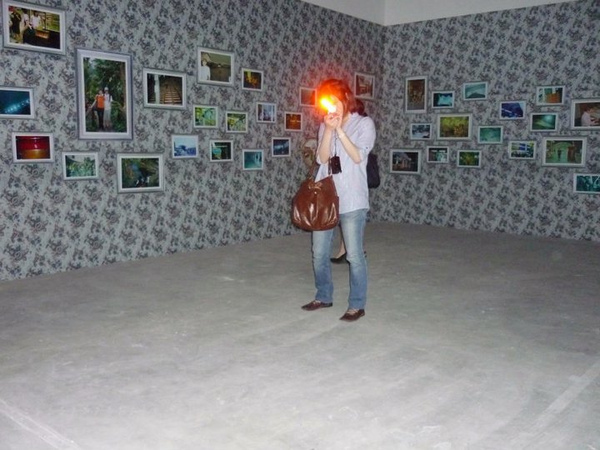
According to modern medicine, if those blind from birth were to one day receive eyesight, and suddenly be able to see the world of light, they would be unable to ‘understand’ the physical world that they see. This shows that our perceptions are not quite as simple as we thought. Humanity’s visual observation of the world cannot help but be influenced by the visual culture around us.
From 2003 to 2007, Pak Sheung Chuen continuously published his conceptual art works in nearly full-page articles in the Hong Kong’s Ming Pao newspaper. These works cleverly brought up emotional points from the details of everyday life in an attempt to awaken potential pathways in the chaotic oppression of reality. Although published in mass media, and even though conceptual art relies on the recording of images, Pak purposefully maintained a distance from the world of image consumerism and globalization.
When the wide variety of image media transmit, exchange, and circulate large volumes of images from other locations, “images are not necessarily the motive force behind new technologies, but they drive imagination, and even force the use of imagination.” Imagination spurs relocation and travel, yet Pak’s A Travel without Visual Experience seems to want to get away from this kind of compulsion. Traveling in a tour group for a five-day / four-night trip to Malaysia from Hong Kong, Pak covered his eyes for the entire journey (throughout the trip, his mother served as his cane, and a photographer joined to document the travels). The fact that Pak used his body in an attempt to “see” without the sense of sight seems to be a reflection on ocularcentrism in a very personal way. In this exhibit, Pak set up the pictures of the blind journey in a lightless darkroom, making visitors experience the “blind observing” for themselves. At the entrance is a sign declaring, “Please take in your camera equipped with flash to take pictures inside,” giving these necessary cameras a ”rebirth.” As a result, visitors begin sleepwalking within the dark space, using the actuality of their blindness to bring them one step closer to becoming conceptual observers. This piece that denies vision, whether through the camera or through observation, in the end points toward the possibility of perception beyond sight.
A Travel without Visual Experience often makes people think of the story of Hun Dun and the Seven Apertures that Zhuang Zi wrote for the emperor. The story tells the tale of three kings named Hun Dun (chaos; the primordial blob out of which heaven and earth divided), Shu (The Fixer) and Hu (Nonchalant). Shu, the king of the South Sea, and Hu, the king of the North Sea, often met in Hun Dun’s central kingdom. The other two kings wanted to repay Hun Dun for his kind treatment. They then noticed that humans possessed eyes, ears, nostrils and a mouth, which allowed them to see, hear, eat and smell, and then realized that Hun Dun did not have any of these. Thus the two kings wanted to drill these seven apertures into Hun Dun. They drilled one every day for seven days, but after the seventh aperture was drilled, Hun Dun died. Pak’s solnambulism seems like a leisurely wandering meant to strip away the body deeply stuck in usual routine, and as a result of opening up a possibility for existence outside this system, assuring that the body is not destroyed by the cultural system.
Written By / Guo, Jau-lan
Associate Professor, Graduate Program in Fine Arts, National Taiwan University of Arts

The concept of somnambulism—can be traced back to ancient Chinese medicine, where it broadly refers to an incompleteness of a person’s soul. The soul, comprised of three finer compounds hun and seven baser instincts po, becomes incomplete, when two huns and six pos are disoriented from the body, or in the condition where a non-native soul inhabits the body of a corporeal host. Somnambulism originally explained the inquilinous relationship between the body and the soul. However, in this world of excessive imagery, faraway imaginings can now travel anywhere. With the huge volume of visions and images circulated throughout society, imagination is no longer restricted to being simply a postscript to reality; they are now completely intertwined with the pulse of the other. Somnambulating has become a communal energy. Rather than endangering the corporeal centrality of the soul, it instead crosses the borders between various worlds: the personal and the communal, reality and virtuality, the illusory and the corporeal, time and space

Figure 1, Auguste François, Kunming, China, 1900
.
Figure 1 shows children in Kunming, China enjoying a Western kinetoscope (photographed by Auguste François of France, 1900), although this form of viewing illusions may have occurred even earlier in Taiwan’s history. According to film historian Ye Long-yan’s The History of Taiwanese Movies During the Japanese Colonization, “The Japanese sold the new toys called kinetoscopes on Jianchang Street in August, 1896... This kind of business involved temporarily renting a space for the kinetoscopes, as they were extremely heavy and bulky, and had to be shipped by boat to the shore of the Danshui River... Taipei’s kinetoscopes were the earliest recorded cinematic experience in Asia.”

Figure 2, Kinetoscope with Phonograph built-in cylinder audio player and earphones, 1895
Although the phrase “uncovering your kinetoscope” explains how “the viewing of visual illusions” entered the Chinese-speaking world, the binary of reality and phantasmagoria was still accepted as a deception of reality. However, following the spread of movies and mass media, the simple real/illusory duality was torn away with the increasingly complex system of capital, media, consumerism, viewers and politics. Illusion morphed into a wide variety of imaginary images, with both a spiritual and physical existence, entwined with all manners of everyday utopia-reliant images. The conjuration of images has now permeated every aspect of our daily lives, weaving illusions and cognition together in contemporary city life.
The intersection of images and illusions is not only seen in the physical nature of tools, but also in the blending and influencing of society. The 17th century Jesuit scholar Athanasius Kircher used the Magic Lantern technique to project images of demons, manipulating rays of light to call forth these spirits.
Etienne Gaspard Robertson was a Belgium projectionist that lived in Paris during the 19th century. He also emphasized that his “phantasmagoria” was in fact the summoning of spirits. Robertson would set up theater-style projections in the ruins of old monasteries, and then make viewers walk through a dark corridor towards a space filled with human skulls. He would mix chemicals to create smoke, and then use a hidden projector to project images onto the smoke while “calling forth the spirits” with a glass harmonica.

Figure 3, Belgian projectionist Etienne Gaspard Robertson performing his Phantasmagoria in the ruins of an old monastery in Paris, 1797
Having grown quite popular in the 19th century, phantasmagoria subtly became a meeting point between life and death, reality and illusion, the corporeal and the spiritual, and the scientific/physical and the emotional. In the meantime, while phantasmagoria fills the need for visual public entertainment, if it also constructs an instrumental culture that deals with the projection of non-existent objects and summoning of collective imaginations: Then how does the dreamland of contemporary media create a connection between our non-existent imaginings?
“All that is solid melts into air.” – Karl Marx. At the end of 2000, Zygmunt Bauman offered “liquid modernity,” echoing Marx’s outcry. Bauman had thought that we had already distanced ourselves from the past notion that “occupying space” is paramount. While the industrial revolution and the era of capitalism focused on solid, concrete modernity, we are now entering the second stage of modernity – liquid modernity. In this liquid modernity, with its prevalence of mass media, internet and instantaneous inter-personal communication, “the restrictions of space and domain no longer form key factors in modern society, as they are replaced by the emphasis liquid modernity places on time, speed and change.”
In the age of the internet, daily life has become more and more like staring through different windows: staring at movies, staring at TVs, staring at computer screens, staring at iPods, staring at cell phones. Windows have been a key element in buildings, and today Windows is the virtually “universal” name for computers. Windows now provides us fugues of entryways entangled with reality. “Mass media allows people to imagine more possible lifestyles than they ever could before, including many which have successfully become a part of our everyday lives,” Modernity at Large author Arjun Appadurai examines images, imaginings and globalization and sees the power in their communal imagination. Imagination in today’s world not only possesses concrete social power, but also offers new resources, and a new energy for creating new races/countries (although some people believe this era is on the verge of ending).
Five artists were invited to present at Somnambulism: Phantasmagoric Fugue, including Taiwanese artists Yao Jui-chung, Yuan Goang-Ming and Wu Chi-Tsung, Korean artist Yeondoo Jung, and Hong Kong artist Pak Sheung Chuen. In the context of their artistic practice, Yuan Goang-Ming and Wu Chi-Tsung find themselves in the reflexive stance of excavating the modernity of video art in a spectacle of image overflow. Yeondoo Jung, on the other hand, wields video art like an illusionistic magician, with the precision of rehearsed film crews and props, while manually employing “long-takes” to challenge the limits of illusion and imagination. Yao Jui-chung, applying the methods of post-archive, evokes an epiphany of collective memory, with a dark-humored veil. Lastly, the artist from Hong Kong, Pak Sheung Chuen traveling with masked eyes, suggests a return to innocence, a feasible path “without visual interference.”
Yeondoo Jung
Six Points

Among the metaphors of photography, memory is considered one of the most common. An old photograph will always link to a memory in the past, providing a reasonable entry point for imagination. It could also imply a convention of documentary, especially a family photograph or archived photos. However, Jung’s aesthetics have consistently been a form of “see the mountain that is a mountain, see the mountain that is not a mountain, and see the mountain that still is the mountain,” a kind of reverse illusion. This may be the most difficult kind of photography to understand, yet one that allows the viewer to experience the happiness of memory and image aesthetics.
Unlike in Handmade Memories, in which movies were used to recreate illusory memories, Jung uses an entirely new route to continue his phantasmagoric memory engineering in Six Points. In this piece, Jung uses cityscape photographs from six immigrant districts in New York to create an animated work. These six areas include the Indian population center of Jackson Heights, Little Italy, Chinatown, Koreatown, Roosevelt Avenue with its high number of Mexican immigrants, and the Russian community of Brighton Beach. The entire animation was created from nearly one thousand photos, stitched together to make a single quiet horizontal landscape/still life; the animation slowly plays against an immigrant's heavily-accented narration.
“I made an animation of a time-frozen city, and you are the only one who is awake and listening to one of these people's life story,” the artist explained in 2006 as he began making this piece in New York. He used a 3000-watt flash installed on a cart to take a single picture every meter along all six of the locations. The flash turned the views into animated movie scenes and the pedestrians into its actors. Jung uses the sounds and memories of immigrants to create completely new local visions that belong to them. Due to its unique geopolitics, the cityscape becomes a stage where immigrants can project their memories.
Reality is found somewhere between truth and imagination. Six Points reflects on a twisted reality, swinging in the gap between the fabricated and the real. Viewers are thrown into the unlimited interstices between the narration of these scattered immigrants and their corresponding streetscapes, the interstices between understandable American English and the various accents of the immigrants’ original countries.
Along with the horizontal movement of scrolls, Jung’s piece opens several wormholes, connecting different time-spaces, within the assembled frozen time fragments of phantasmagoria. In discussing the existence of these drifting immigrants, Six Points provides a contradictory imagination of disorientation and reorientation under the displacement of time and space. The relationship between the images and the colloquial narrative expands the distance between them, to a blurred, indeterminate zone existing between the individual and the communal.
Weaving together the images from these six city points, Jung creates an imaginary city that expands horizontally. It is a dense, high-resolution artificial view, an illusory city that has cast off the wheels of time. If this virtual streetscape—constructed of real streets, but also emitting electronic glow–does not reflect the imagination and reality of those cross-global immigrants, then this non-existent cityscape would be the phantasmagoric city within all globalized cities: A phantasmagoric city that exists everywhere. It invariably resides between reality and imagination, mediating the fluidity of identity, yearning and memory.
Hanging Garden


An old story helps explain the tradition of images and illusions. In “Natural History,” Pliny the Elder described a competition between two outstanding painters of ancient Greece, Zeuxis and Parrhasius, to see who could create the most convincing illusion. First, Zeuxis painted grapes, which were so vivid that small birds that came to peck at them. Able to even fool mother nature with his optical illusion (trompe l’oeil), Zeuxis was certain of his victory. He confidently walked towards Parrhasius’ work, saying, “Draw back the curtains on your piece, and let us see what you have painted!” Zeuxis was shocked to find that the curtains covering his opponent’s work were in fact the painting itself. Zeuxis was fooled by Parrhasius’ illusion, and was forced to admit defeat.
When Jacques Lacan recounted this fable in 1964, these two artists each clearly demonstrated two kinds of image: one, the ability to attract, and the other, the ability to deceive the eyes. Parrhasius’ image was a metaphor for paintings that are like a veil, so that people are enticed to ask what is behind them. If Parrhasius’ cloth curtains were an allegory for an image acting as visual bait, then Jung’s Hanging Garden transforms the illusion of the grapes into the “live-action realism” of “finding a view in the vineyard.” Jung makes this infinitely familiar media bait both broad and expansive, and asks “where will the persuasiveness of images take us?”
True to the film host’s words, Hanging Garden is a live-action film. Jung utilizes the narrative strategy commonly adopted by mainstream media: shot a real place, with the narration of history, stories of people and background images often seen in weather reports, and add an authoritative host that occasionally refers to the images. The scene behind the curtain is the Gyeongbok Palace in Seoul, built during the Korean Joseon Dynasty in the 14th century. The artist selected dusk for this scene, captured by setting up a camera on the roof of the nearby Korean Defense Security Command in a single-shot documentary style. Nothing is artificial in the scene behind the host except for the curtain and a few trees in the foreground. Yet the historical allusion narrated by this solemn host is completely fabricated and baseless; it simply once again uses the convention of an authoritative narration.
The host stands within a television-like frame, slowly moving the curtain, as he authoritatively explains the distant objects behind him. Along with his commanding narrative, he also slowly moves his body as the audience solemnly listens to his unfolding story. With the real background objects clearly shown, the ‘reality’ of the scene transforms into the ‘evidence’ of the host’s narration. The scene between the curtains can be likened to the images placed behind television news anchors. The real and the fabricated instantly decouple. Gyeongbok Palace, which could not be more a concrete entity, suddenly becomes ’suspended leading us to think that the ‘hanging’ in the title of this piece hints at much more than merely a “suspended” garden.
Viewers will also see some of the making process behind Hanging Garden on a smaller screen, including the team’s careful planning process and the moving of the props. Jung’s work reveals those things that are invisible, such as stage props and the actual performance itself, to create a gray area between imagination and imagery. The high-tech 3D digital processing and the cuts, are achieved instead with the most non-technological, ‘realistic,’ and mechanically precise methods possible, along with the physical exertion of rehearsal. On the one hand he utilizes photography and cameras, while on the other, he is suspicious of the transparency of photography and cameras. But the important point is that Hanging Garden was not planned to extinguish the allure of illusionary images; the act of contemplation simply does not end such a dialogue due to deceit.
Yao Jui-chung
Phantom of History Series

“Having lived through the turbulent 90’s, everything around you seemed empty, drifting balloons, light and airy. Yet the past does not disappear, it simply transforms into phantoms, hovering about in the air.” Growing up in the 1960’s, Yao Jui-chung took the collective memory of Taiwan’s martial law at the time and brought them back to life. This makes one think of Jacques Derrida’s words, “"It is never to rest, interminably, from searching for the archive right where it slips away.
It is to run after the archive, even if there's too much of it, right where something in it anarchives itself.".
In the Phantom of History series, the artist seems to have been possessed by the phantom of history itself, which shows itself in three different scenes: Jade Mountain, a march past the Office of the President, and the Chiang Kai Shek Memorial Sculpture Park in Cihu. The first two image prototypes are from the martial law era, when the national machine created a kind of leader-worshipping in the media. Remolding memory is often a necessary tool in the formation of the nation. But if the nation is phantomized, then the spirit will reside in the individual. Here history becomes a ready-made object from collective memory, waiting to be created, deployed, allocated or recreated. As Yao ridicules the illusions of the martial law state, he also projects a contemporary media-saturated collective political consciousness.
Chinatown – Dizzy

Chinatown – Dizzy traces its origins from Yao’s project entitled The World is For All – China Beyond China, begun in 1997. Yao traveled to Chinatown gates in major cities around the world, including Vancouver, Toronto, Philadelphia, Paris, New York, Victoria, San Francisco, Yokohama, London, Brisbane and Taipei, using his body as an “I was here” to ask the question “Just where is China?” While exploring the concept of self-identification, globalism and political identification. Yao’s Chinatown – Dizzy is performance / video art conducted at the Chinatown in Yokohama.
In front of a spinning video camera, Yao slowly walks into the picture and performs handstands, even as the frame continues to spin. As the artist reaches the center of the picture, precisely as the image turns upside-down, he completes his handstand. Whether he is attempting to use his body to prove “I was here,” or using the upside-down image / body to overturn each other, the scene created is similar to the predicament faced by immigrants moving into these areas. This turning upside down is dizzying – much like the turning over of dreams.
Yuan Goang-Ming
Disappearing Landscape – Passing

In the documentary The Man with a Movie Camera, Russian director Dziga Vertov describes the camera: “I am an eye, a mechanical eye. I, the machine will show you your world the way only I can see it. I free myself for today and forever from human immobility. I’m in constant movement. I approach and pull away from objects. I creep under them. I move alongside a running horse’s mouth. I fall and rise with the falling rising bodies. This is I, the machine.” The director uses the style of montage to create the personification of cameras, much like the film today, preserving the parable of the camera: long-legged cameras (Figure 4).

Figure 4, Dziga Vertov The Man with a Movie Camera jacket
Disappearing Landscape – Passing involves installing three cameras on straight steel wires at different heights, with motors attached to the cameras to allow them to slowly move along. After computer post-processing, the images are suddenly thrust into everyday scenes, rotating around as if to flee. Moving cameras make people think of the classic walking camera images. What is different, however is that Vertov believed that the camera eye he held would cast off the rigidness of humanity, and show people what they are incapable of. Yet Yuan’s steel wires seem to return these metaphor-loaded tools of modern utopia to a kind of original pre-modern form. Sliding cameras facing a non-existent vanishing point subtly cuts apart and pierces through time and space, passing us by with every disappearing moment of daily life.
The images that slip into Disappearing Landscape – Passing compress real time and the timing of moving cameras into one. The timing of the image frames are sliced into pieces, overlapped with the timing of the physical movement, giving people an image of time itself collapsing. As a result, this piece interprets time, which is difficult to describe, within the context of space. Yet due to the existence of visual narrative, the moving images naturally tell of a vanishing past. When those everyday sights of the artist enter the shot, the laws of universal time are not cast away. Using ça-a-été as truth, these are mixed into a single entity, giving it the title ‘we were here.’ They mix the ideas of existing and existed, yet what is gone is gone, and all we have left is the image of ‘we were here,’ much like a ghost. The melancholic nature of photography creates an apprehension within Disappearing Landscape – Passing.
Wu Chi-Tsung
Dust

In Time Exposure and Snapshot: The Photograph as Paradox, Thierry de Duve explained, “More than any other image-producing practices, the photograph puts the beholder in contact with the world, through a paradoxical object which, because of its indexical nature, belongs to the realms of uncoded things, and to the sphere of codified signs.” He went on to say, “Photograph doesn’t allow an intermediate position, or a dialectic resolution of the contradiction.”
If what de Duve refers to here is the contradictory nature of visual signs for photography as an observational tool, then Wu Chi-Tsung dismantles the technological black-box of the visual tool,, that interferes with the tools’ phony transparency to provide image tools with alternative concepts through the language of media art. The interesting thing is that Wu starts from reflecting on image observation technology, and invariably winds up summarizing through the details of profound images, cleverly directing us to the “spirited artistic concepts” of Chinese ink paintings.
In terms of reflecting on and understanding images, especially in this world created by image-based media, with things of the corporeal lost in the process of sensory transitions, Wu Chi-tsung possesses profound observational skills. Dust is an installation piece created by the mis-placement of video recorders and projectors in a darkroom. When visitors enter the darkroom, the video camera stares at the light-emitting projector, creating a feedback loop within the space. Due to this intentional misuse by the artist, the aperture and lens inside the camera no longer connect to the outside world and internal images. Viewers are pulled into the camera, with their bodies intervening in the “ Mysterious Bermuda Triangle” between the lens and the screen. This unknown zone between the viewer and the world becomes an energy field that transforms into an observational theater. Since images no longer possess an mimetic nature, ones before the camera have shaken off the limitations of being indexical signs, highlighting the switching the energy field and particles in which the host / guest relationship is reversed. Through the artist’s “illegal usage,” Dust successfully expands the image media’s ability to express, and evokes deterritorialized visual and corporeal senses.
Pak Sheung Chuen
A Travel without Visual Experience

According to modern medicine, if those blind from birth were to one day receive eyesight, and suddenly be able to see the world of light, they would be unable to ‘understand’ the physical world that they see. This shows that our perceptions are not quite as simple as we thought. Humanity’s visual observation of the world cannot help but be influenced by the visual culture around us.
From 2003 to 2007, Pak Sheung Chuen continuously published his conceptual art works in nearly full-page articles in the Hong Kong’s Ming Pao newspaper. These works cleverly brought up emotional points from the details of everyday life in an attempt to awaken potential pathways in the chaotic oppression of reality. Although published in mass media, and even though conceptual art relies on the recording of images, Pak purposefully maintained a distance from the world of image consumerism and globalization.
When the wide variety of image media transmit, exchange, and circulate large volumes of images from other locations, “images are not necessarily the motive force behind new technologies, but they drive imagination, and even force the use of imagination.” Imagination spurs relocation and travel, yet Pak’s A Travel without Visual Experience seems to want to get away from this kind of compulsion. Traveling in a tour group for a five-day / four-night trip to Malaysia from Hong Kong, Pak covered his eyes for the entire journey (throughout the trip, his mother served as his cane, and a photographer joined to document the travels). The fact that Pak used his body in an attempt to “see” without the sense of sight seems to be a reflection on ocularcentrism in a very personal way. In this exhibit, Pak set up the pictures of the blind journey in a lightless darkroom, making visitors experience the “blind observing” for themselves. At the entrance is a sign declaring, “Please take in your camera equipped with flash to take pictures inside,” giving these necessary cameras a ”rebirth.” As a result, visitors begin sleepwalking within the dark space, using the actuality of their blindness to bring them one step closer to becoming conceptual observers. This piece that denies vision, whether through the camera or through observation, in the end points toward the possibility of perception beyond sight.
A Travel without Visual Experience often makes people think of the story of Hun Dun and the Seven Apertures that Zhuang Zi wrote for the emperor. The story tells the tale of three kings named Hun Dun (chaos; the primordial blob out of which heaven and earth divided), Shu (The Fixer) and Hu (Nonchalant). Shu, the king of the South Sea, and Hu, the king of the North Sea, often met in Hun Dun’s central kingdom. The other two kings wanted to repay Hun Dun for his kind treatment. They then noticed that humans possessed eyes, ears, nostrils and a mouth, which allowed them to see, hear, eat and smell, and then realized that Hun Dun did not have any of these. Thus the two kings wanted to drill these seven apertures into Hun Dun. They drilled one every day for seven days, but after the seventh aperture was drilled, Hun Dun died. Pak’s solnambulism seems like a leisurely wandering meant to strip away the body deeply stuck in usual routine, and as a result of opening up a possibility for existence outside this system, assuring that the body is not destroyed by the cultural system.
全站熱搜



 留言列表
留言列表